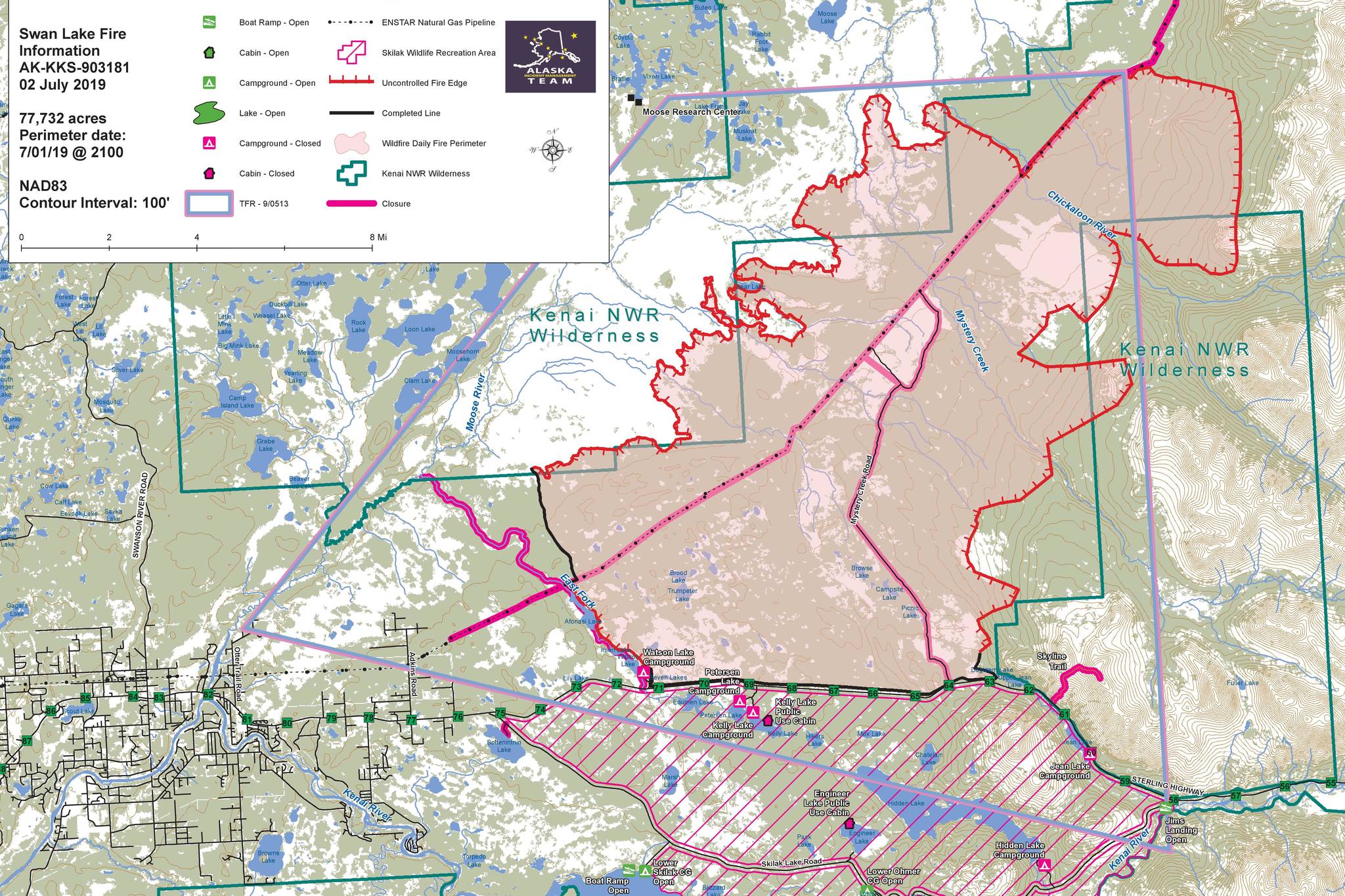The Swan Lake Fire continues to blaze through the Kenai National Wildlife Refuge and, at various times since first starting on June 5, has prompted smoke advisories, a fireworks ban, trails and campground closures, traffic delays and a temporary flight restriction. As of a June 2 update from the Alaska Incident Management Team, the fire is currently 77,732 acres in size and has a total of 454 personnel working to protect important infrastructure, the Sterling Highway, the community of Sterling and the Homer Electric Association’s transmission line that runs parallel to the highway.
On Monday, crews focused on mop-up and suppression repair operations along 18 miles of fire break just north of the Sterling Highway. Meanwhile, the fire lines east of Sterling held strong after being tested by hot, dry weather. Personnel from the HEA worked with firefighters to inspect the transmission line, and further fire mitigation is expected to take place before the line is turned back on.
The fire continues to spread primarily east-northeast through thick strands of black spruce in the backcountry of the Kenai National Wildlife Refuge. Protection of public use cabins in the area and the ENSTAR gas pipeline remains a priority.
Daniel Patterson, public information officer for the Incident Management Team, said that the status of the fire can change on a daily basis depending on the wind, but the priority for firefighters on the ground is mopping up burned areas and securing established fire lines. Patterson said the fire will remain active until significant rainfall hits the area.
“It’s important to note that, whenever this is all over, the area will be much more resilient to future fires, and communities like Sterling will be a lot safer,” Patterson said.
Incident Meteorologist Ben Bartos said that no rain is forecasted any time soon. The Kenai Peninsula has been consistently hot and dry for the duration of the fire, and Bartos said that the temperature in the area has been above-average for a longer amount of time than normal. The increased temperatures are partly caused by a high-pressure system located to the south of the peninsula, which Bartos said was pushed away slightly over the weekend by a weak cold front originating near Point Hope. Starting Thursday, Bartos said, the high-pressure system will return and temperatures on the peninsula are expected to increase once again. The fire itself, Bartos said, has not yet had an impact on local weather systems, but the formation of pyrocumulus clouds could occur at some point and would result in increased smoke, unpredictable winds and lightning storms in the area.
Smoke conditions on the peninsula were moderate on Monday, and an air quality advisory was issued by the Department of Environmental Conservation on July 1, and smoke will be continue to be an issue.
Tami Marsters, public health nurse for the Kenai Public Health Center, said that children and the elderly should especially be aware of changing smoke conditions in the area. Wildfire smoke can cause a variety of symptoms, including asthma/COPD attacks, chest pain, coughing, congestion, fatigue, headaches, irritated sinuses, rapid heartbeat, runny nose, scratchy throat, shortness of breath, stinging eyes and wheezing.
“Try to encourage your kids to stay inside on the days that are particularly bad,” Marsters said. “Admittedly, not an easy task with this beautiful weather.”
According to information from the Department of Health and Human Services, respirator masks labeled R95, N95 or P95 can filter out much of the smoke in the air, but they must have an airtight seal in order to be effective. The respirator masks also increase resistance to airflow and can cause increased breathing and heart rates in some individuals. The best way to limit exposure to smoke is to stay indoors on bad days with the windows and doors closed.
The best place to get information on the current air quality conditions on the peninsula can be found at the University of Alaska Fairbanks smoke prediction website.
The Department of Public Safety issued a ban on the sale and use of fireworks on the Kenai Peninsula and the ban is expected to remain in place through the weekend, including on the Fourth of July.
Traffic along the Sterling Highway experienced minor delays on Monday due to road construction resuming. Firefighters and construction workers are working along the road and nighttime smoke inversions may cause further delays throughout the week.
A Temporary Flight Restriction is in effect for the area over the fire, and pilots can confirm current restrictions at https://tfr.faa.gov/save_pages/detail_9_0513.html.
The Skilak Lake Wildlife Recreation Area partially reopened on Monday to allow public use at Lower and Upper Ohmer Lakes, Lower Ohmer Campground, Upper and Lower Skilak Lake Campgrounds and Upper Ohmer Lake Cabin. Skilak Lake Road, along with Jim’s, Upper, and Lower Skilak landings also remain open. For more information on the closures, contact the Refuge Visitor Center at 907-260-2820.
Officials for the Mount Marathon Race in Seward on July 4 have issued an announcement due to the persistent smoke from the Swan Lake Fire. According to the announcement, all registered runners will be allowed to defer their 2019 entry to the 2020 race if they choose not to run due to air quality. This includes lottery winners, priority racers, petitioners and special invites. The deferral form and the announcement can be found at the Mount Marathon website.
For the latest on the Swan Lake Fire, visit kpboem.com.

